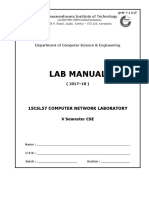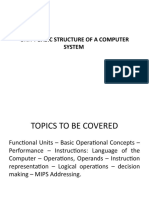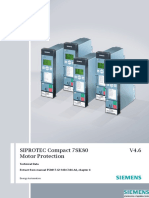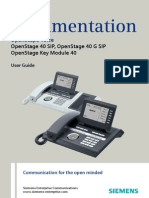Simstd Apr 2003 Hints
Simstd Apr 2003 Hints
Uploaded by
Gretchen BouCopyright:
Available Formats
Simstd Apr 2003 Hints
Simstd Apr 2003 Hints
Uploaded by
Gretchen BouCopyright
Available Formats
Share this document
Did you find this document useful?
Is this content inappropriate?
Copyright:
Available Formats
Simstd Apr 2003 Hints
Simstd Apr 2003 Hints
Uploaded by
Gretchen BouCopyright:
Available Formats
Hints, Tips and Solutions
Colin Shaw, Applications and Support Engineer
Q. How do I make my long simulation more memory to ground to these nodes to allow spice to achieve a DC
efficient ? solution .OPTIONS DEPATH =<val> .The spiceusr1.pdf in
chapter 2.12 contains options broken up into categories like
When you run a long simulation time analysis the evalu-
convergence and we welcome any customer feedback on
ated time points are normally all held in memory until
the manual information.
the end time is reached. All the data is then written out to
the output rawfile. This means a large amount of system
memory can be used up and also has to be tracked. If in Q. I kill my SmartSpice program but the license is not
the input deck the line “.OPTIONS RAWPTS=300 POST” available in Linux ?
is included then as soon as the maximum number of When you invoke SmartSpice you can run it in the Fore-
points is reached given by “RAWPTS=300” then all the ground or the background by use of the “&” character at the
vector data is saved to the raw data output file and the end of the command line. Programs run in the background
memory is free to be re-used. In this way the output raw- return the prompt straight away to the invoking window,
file is incrementally increased in size every time this limit programs run in the foreground wait for the completion
is reached. The memory required by the simulation run is of the program to return to the prompt. If the program
therefore reduced, and with less memory to manage, the is run in the foreground and then <cntrl>”C” is done the
simulation is run faster. This is particularly useful on the operating system still holds onto the process hence License
PC platform where some of the memory is required for is not available. To put a process into the background the
the operating system and RAM size is less than 1Gig. <cntrl>”Z” should be done AND then the command “bg”
to place in the background and the system will release the
Q. What is the difference between .MODIF & .ALTER process. The License is therefore available for the next ver-
for simulation run variance ? sion of SmartSpice. ( There is a License time-out feature
but this will take a while to release the License )
The .ALTER is used to globally change the circuit topol-
ogy like slotting in another sub-circuit or changing a
component. This change in the circuit is like submitting Q. I know SPICE is an Analog simulator but can I gen-
a new deck and can be incorporated in a distributed erate a digital source ?
system among a group of computers to get maximum There are 2 steps to generating a digital source, first the wave-
utilization of the resources. The .MODIF is more for form timing and second the pulse train of “0”’s and “1”.
changing parameter values associated with a model etc.
A SPICE input deck example is:
Q. My simulation fails with no convergence what extra Digital source config.
information can I obtain ?
* PWLFILEDESC.
The spice simulation of a circuit is based on a good model .param tri=150ps tfi=150ps
of the elements and sensible circuit construction. If you * PWLFILEDESC format is:
include the line “.OPTIONS EXPERT” you will get a lot * ( data_type start delay vlow vhigh fall
of reporting turned on showing model card parameter rise )
evaluation and floating nodes of the circuit. It would be * data_type= 1 - time current pairs, = 2
sensible to cut down the simulation time before turning time voltage pairs
this option on to save too much duplication of the errors *
everytime they are encountered. This reporting gives the vin inp 0 pwlfiledesc( 2 0 3ns 0v 3.3v
user more information to construct a better simulation ‘tri’ ‘tfi’ ) pwlfile test3.dat
deck. Commonly the model construction can be at fault
and this option allows the user to go back to his model pro- vcc 0 vss dc -3.3v
vider with highlighted problem areas. The other common
m1 2 inp vss vss pm w=32u l=1.6u
problem is having an isolated section of circuitry without a
m2 2 inp 0 0 nm w=10u l=1u
DC path to ground. This can happen if a section of circuitry
C1 2 0 0.01f
is connected only through a set of capacitance elements
for example. Here the user will need to add conductance
The Simulation Standard Page 10 April 2003
.MODEL NM NMOS LEVEL = 49
.MODEL PM PMOS LEVEL = 49
.tran 0.1ns 50ns 0.1ns
.print v(inp) v(2)
.temp 125
.option nomod
.END
and the referenced file (test3.dat) contains the digital
string “010110010”
What noise analysis can I do on my circuit in SmartSpice?
There are 3 ways to take account of noise in your circuit.
First there is the traditional .NOISE analysis used to
calculate the noise of each component. From there the
Figure 1. Digital source - input and circuit output.
spectral density is obtained and the integrated noise
over the specified frequency range used to calculate the
output and the input referred noise. Second there is the operating region for all device geometries. Sometimes
.TRAN NOISE which calculates the noise contributions there is too much variation in the output characteristics
of each circuit node and solves the stochicometric set of to be covered by one continuous model parameter set
equations for each time point in the transient analysis. e.g. “straight” and “dog-bone” layout designs which
And finally there is a new spice element “N” introduced contain very different electric field patterns. The total
in SmartSpice 2.3.8.C, and higher, to allow users to inject operating region is therefore broken up into sub-sections
noise at a particular circuit node. This noise is in addi- and a model produced for each of these subsets of device
tion to the element sources of noise and allows for contri- geometry. This is a binned model where each region is
butions like substrate referred noise from other parts of a different set of model card values for a smaller range
the circuit and general circuit succeptability to external of device properties like width, length and temperature.
noise sources. In this way a group of model card parameter sets can
be used to cover a wide variation in say gate width and
length variations not possible from a single scaleable
Q. My long simulation run consumes all resources and
model. In the simple case these bins are ranges of Width
then freezes ?
and Length transistor geometries that say what model
This happens when you use a PC system with less than card parameter set should be used. The only problem
1Gig of RAM or a small amount available hard disc space with this approach is a discontinuity at the boundary of
and a very long simulation time recoding all circuit node one model set to another and can be thought of as trying
activities. A new feature “.OPTIONS SAFEMODE” was to approximate a curve with a set of straight lines. Your
introduced to warn of this happening and it stops the error is because the device geometry is not covered by
simulation when either the hard disc space or the avail- any of the specified ranges in the model library. Typi-
able memory gets below 50Megs. It is then up to the user cally the binned model will have a model name of say
to close other programs and free more resources or con- nch.1, nch.2, nch.3 etc. and you device geometry is not al-
tinue at risk running out of space. The other ways are to lowed for in the say Lmin to Lmax range of any of these
limit the simulation time to something more reasonable or binned model sections.
limit the vectors that are saved rather than having every-
thing saved even circuit nodes that are not critical. To do
this instead of the “.SAVE ALL” you can use 2 pre-defined
macros to record vectors from part of the whole circuit.
Call for Questions
Xx - defines If you have hints, tips, solutions or questions to contribute,
please contact our Applications and Support Department
Phone: (408) 567-1000 Fax: (408) 496-6080
Q. My simulation fails because SmartSpice cannot e-mail: support@silvaco.com
find a binned model, what does this mean ?
Hints, Tips and Solutions Archive
Normally when a MOS model is extracted for a range of Check our our Web Page to see more details of this example
plus an archive of previous Hints, Tips, and Solutions
devices it is scaleable over the range of device geometries
i.e. it is a continuous varying function over the required
www.silvaco.com
April 2003 Page 11 The Simulation Standard
You might also like
- Avalon EMS Industry in India Final Report 04august2022Document60 pagesAvalon EMS Industry in India Final Report 04august2022Rajat Nikam0% (1)
- Full Chip Verification FlowDocument7 pagesFull Chip Verification FlowSamNo ratings yet
- ANTENA HUAWEI ATR4518R13 1805 DatasheetDocument2 pagesANTENA HUAWEI ATR4518R13 1805 DatasheetVíctor Balloqui82% (11)
- Control - Panel TJ 509T PDFDocument140 pagesControl - Panel TJ 509T PDFAnonymous V9fdC677% (13)
- Dungeon Session WorksheetDocument17 pagesDungeon Session WorksheetmokhtarkanNo ratings yet
- FPGA Interview QuestionsDocument11 pagesFPGA Interview Questionssneha587No ratings yet
- Redundancy, RepairDocument8 pagesRedundancy, RepairSabarish IttamveetilNo ratings yet
- User Guide Incompact3d V1-0Document8 pagesUser Guide Incompact3d V1-0Danielle HaysNo ratings yet
- Introduction To Multisim 12Document11 pagesIntroduction To Multisim 12Madhuri RoyNo ratings yet
- Lec 44 MulticoreDocument23 pagesLec 44 Multicoreselvakrishnan_sNo ratings yet
- ACA2024Document44 pagesACA2024aktemp.777No ratings yet
- Homework 1: Wireless Sensor NetworksDocument3 pagesHomework 1: Wireless Sensor NetworksNgọc TháiNo ratings yet
- Walther U GLOBECOM 99Document5 pagesWalther U GLOBECOM 99nabila brahimiNo ratings yet
- Hspice UseDocument28 pagesHspice Useprasanna810243100% (1)
- Analog Design Assignment: Analog and Digital VLSI Design - EEE C443 February 1, 2012Document9 pagesAnalog Design Assignment: Analog and Digital VLSI Design - EEE C443 February 1, 2012srishaharidasNo ratings yet
- Simpledsp: A Fast and Flexible DSP Processor Model: (Extended Abstract)Document6 pagesSimpledsp: A Fast and Flexible DSP Processor Model: (Extended Abstract)Alex ObrejanNo ratings yet
- Network Lab ManualDocument64 pagesNetwork Lab Manualget_togetherNo ratings yet
- Parallel Computing IntroductionDocument36 pagesParallel Computing IntroductionajishalfredNo ratings yet
- Digital Systems 2: Subject StudentDocument6 pagesDigital Systems 2: Subject StudentP8YCG9PW64No ratings yet
- Scilab Ninja: Module 6: Discrete-Time Control SystemsDocument8 pagesScilab Ninja: Module 6: Discrete-Time Control Systemsorg25grNo ratings yet
- Itss Lab6Document3 pagesItss Lab6MANSI BISHTNo ratings yet
- 10CSL77 NETWORK - Lab PDFDocument39 pages10CSL77 NETWORK - Lab PDFNooruddinSahebNo ratings yet
- Cs501 Solved Subjective Final Term by JunaidDocument32 pagesCs501 Solved Subjective Final Term by JunaidKhan HackerNo ratings yet
- Cse410 Sp09 Final SolDocument10 pagesCse410 Sp09 Final Soladchy7No ratings yet
- Chap2 SlidesDocument127 pagesChap2 SlidesDhara RajputNo ratings yet
- Debugging Mixed Signal AMSDocument28 pagesDebugging Mixed Signal AMSarunsrlNo ratings yet
- Unit I-Basic Structure of A Computer: SystemDocument64 pagesUnit I-Basic Structure of A Computer: SystemPavithra JanarthananNo ratings yet
- Pipeline v1Document13 pagesPipeline v1vinilmNo ratings yet
- Systemverilog UVM QADocument9 pagesSystemverilog UVM QAAshwini PatilNo ratings yet
- V Models of Parallel Computers V. Models of Parallel Computers - After PRAM and Early ModelsDocument35 pagesV Models of Parallel Computers V. Models of Parallel Computers - After PRAM and Early Modelstt_aljobory3911No ratings yet
- Modelling Large Systems - Alternatives For Network EquivalentsDocument2 pagesModelling Large Systems - Alternatives For Network EquivalentselhaffarNo ratings yet
- Digital Design Using VHDL: Topic: Huffman Decoder Using VerilogDocument14 pagesDigital Design Using VHDL: Topic: Huffman Decoder Using VerilogTùng Lâm VũNo ratings yet
- Low Power VLSI Unit 3Document8 pagesLow Power VLSI Unit 3Vamsi Krishna KuppalaNo ratings yet
- CN Lab ManualDocument45 pagesCN Lab ManualHanumanthu Mothukuru100% (1)
- AMP ManualDocument22 pagesAMP ManualRagini SundarramanNo ratings yet
- PracticeProblems COA8eDocument40 pagesPracticeProblems COA8eAnousith PhompidaNo ratings yet
- KernrateDocument22 pagesKernrateSandro ReimãoNo ratings yet
- Report On Mpsoc'04: Students' Summary of Lectures Xi ChenDocument45 pagesReport On Mpsoc'04: Students' Summary of Lectures Xi ChenRachana SrinivasNo ratings yet
- Multicores, Multiprocessors, and P, ClustersDocument51 pagesMulticores, Multiprocessors, and P, ClustersAdip ChyNo ratings yet
- Sheet3 CmsDocument4 pagesSheet3 Cmsrob bobNo ratings yet
- The Three Tier AbstractDocument5 pagesThe Three Tier AbstractManoj Kumar MohanNo ratings yet
- Csi 3131 Midterm W13 SolnDocument10 pagesCsi 3131 Midterm W13 SolnAndrey SafonovNo ratings yet
- Writing Fast Matlab Code PDFDocument29 pagesWriting Fast Matlab Code PDFМилан ЛукићNo ratings yet
- Network Performance TestingDocument12 pagesNetwork Performance TestingadiclNo ratings yet
- Summary Master ThesisDocument3 pagesSummary Master ThesisAldoConteNo ratings yet
- Automated Design Techniques For Low-Power High-Speed CircuitsDocument4 pagesAutomated Design Techniques For Low-Power High-Speed CircuitsIrma AmeliaNo ratings yet
- Incompact3D User Guide Version 2.0: Sylvain Laizet (Imperial College London)Document13 pagesIncompact3D User Guide Version 2.0: Sylvain Laizet (Imperial College London)Yi ZhouNo ratings yet
- The Lecture Contains:: Lecture 15: Memory Consistency Models and Case Studies of Multi-CoreDocument9 pagesThe Lecture Contains:: Lecture 15: Memory Consistency Models and Case Studies of Multi-CoreProdip KunduNo ratings yet
- 10csl77 Network LabDocument39 pages10csl77 Network LabshivaspyNo ratings yet
- Ce - Conf UsageDocument20 pagesCe - Conf UsageRakesh SinghNo ratings yet
- HW1 SolutionDocument3 pagesHW1 Solutionryle34No ratings yet
- A New WPAN Model For NS-3 Simulator: K. El Ghomali, N. Elkamoun, K. M. Hou, Y. Chen, J.P. Chanet, Jian-Jin LiDocument9 pagesA New WPAN Model For NS-3 Simulator: K. El Ghomali, N. Elkamoun, K. M. Hou, Y. Chen, J.P. Chanet, Jian-Jin LiEmily Gisella Estupiñan ChawNo ratings yet
- TFT Design Flow 08Document8 pagesTFT Design Flow 08Nikhil PuriNo ratings yet
- PDC ASS1 Reg No 21mdbcs116 Sec ADocument7 pagesPDC ASS1 Reg No 21mdbcs116 Sec Aahsan wahabNo ratings yet
- Chapter 06Document76 pagesChapter 06Charly ElviraNo ratings yet
- Resolve Infinite Loop Zero Delay GLSDocument9 pagesResolve Infinite Loop Zero Delay GLSJagadish KgNo ratings yet
- Dma Controller ThesisDocument6 pagesDma Controller ThesisBuyCollegePapersOnlineHuntsville100% (2)
- Design and Test Strategies for 2D/3D Integration for NoC-based Multicore ArchitecturesFrom EverandDesign and Test Strategies for 2D/3D Integration for NoC-based Multicore ArchitecturesNo ratings yet
- Embedded Deep Learning: Algorithms, Architectures and Circuits for Always-on Neural Network ProcessingFrom EverandEmbedded Deep Learning: Algorithms, Architectures and Circuits for Always-on Neural Network ProcessingNo ratings yet
- Gain-Cell Embedded DRAMs for Low-Power VLSI Systems-on-ChipFrom EverandGain-Cell Embedded DRAMs for Low-Power VLSI Systems-on-ChipNo ratings yet
- Arduino Measurements in Science: Advanced Techniques and Data ProjectsFrom EverandArduino Measurements in Science: Advanced Techniques and Data ProjectsNo ratings yet
- Programming Your GPU with OpenMP: Performance Portability for GPUsFrom EverandProgramming Your GPU with OpenMP: Performance Portability for GPUsNo ratings yet
- Tda 1083Document12 pagesTda 1083mplennaNo ratings yet
- Black Start Diesel Gen. SystemDocument29 pagesBlack Start Diesel Gen. SystemعليفاضلNo ratings yet
- Summary Architecture GSM & Wcdma: Mtr. Axel Abraham Valdes VargasDocument66 pagesSummary Architecture GSM & Wcdma: Mtr. Axel Abraham Valdes VargasEdwin David VNo ratings yet
- SIPROTEC Compact 7SK80 V4.6 Motor Protection: Technical Data Extract From Manual E50417-G1140-C344-A4, Chapter 4Document70 pagesSIPROTEC Compact 7SK80 V4.6 Motor Protection: Technical Data Extract From Manual E50417-G1140-C344-A4, Chapter 4Surachat SannokNo ratings yet
- 9619 Philips 32PFL3605 42PFL3605 Chassis RAM1 0A LA Televisor LCD Manual de Servicio PDFDocument66 pages9619 Philips 32PFL3605 42PFL3605 Chassis RAM1 0A LA Televisor LCD Manual de Servicio PDFMaya Tes100% (1)
- Trinity PDFDocument16 pagesTrinity PDFTong Nguyen100% (1)
- How To Interface LCD With ArduinoDocument7 pagesHow To Interface LCD With ArduinoMukul VaishnavNo ratings yet
- User Manual OpenStage 40 SIPDocument217 pagesUser Manual OpenStage 40 SIPEtienne LamyNo ratings yet
- Jabra Speak 510 User Manual - EN RevFDocument21 pagesJabra Speak 510 User Manual - EN RevFcsudhaNo ratings yet
- Serial Communication Protocols and RTCDocument15 pagesSerial Communication Protocols and RTCMukesh PatidarNo ratings yet
- 6.02 Nbits +1.76 25,84 DB: SNR V VDocument2 pages6.02 Nbits +1.76 25,84 DB: SNR V VHelder CruzNo ratings yet
- Astronergy CHSM6612P 3BB 40mm Frame 20151014Document2 pagesAstronergy CHSM6612P 3BB 40mm Frame 20151014J AANo ratings yet
- 415midterm Exam Routine Spring 2020 Update On 23-08-20Document1 page415midterm Exam Routine Spring 2020 Update On 23-08-20TanimunNo ratings yet
- Practical 1 - Logic GatesDocument13 pagesPractical 1 - Logic Gatessmriti.dubeyNo ratings yet
- L2CN :network Layers and Physical LayerDocument12 pagesL2CN :network Layers and Physical LayerAhmad ShdifatNo ratings yet
- Course Outline (Wireless Network)Document8 pagesCourse Outline (Wireless Network)aqsaraliNo ratings yet
- Sampling and Aliasing: ObjectiveDocument6 pagesSampling and Aliasing: ObjectiveMuhammadAxadKhataabGujjarNo ratings yet
- Littelfuse Hall Effect Sensors 55140 Datasheet PDFDocument3 pagesLittelfuse Hall Effect Sensors 55140 Datasheet PDFNicacio LucenaNo ratings yet
- Power Management - PPTDocument21 pagesPower Management - PPTsuvendra123No ratings yet
- Luis III Ariel Garza Narváez Liceo #488, Centro, C.P. 44270, Guadalajara, Jalisco, México Tel. +52 - (33) - 3614-7838 Cel. +521 - (33) - 1358-0950Document2 pagesLuis III Ariel Garza Narváez Liceo #488, Centro, C.P. 44270, Guadalajara, Jalisco, México Tel. +52 - (33) - 3614-7838 Cel. +521 - (33) - 1358-0950api-28634674No ratings yet
- RTU500 Series Review and News - UAE Dec.2013Document38 pagesRTU500 Series Review and News - UAE Dec.2013T Dung LuNo ratings yet
- CM20230404 1795c F8e3fDocument16 pagesCM20230404 1795c F8e3fzeeshan0012046No ratings yet
- PanelMeterCatalog Jan09Document68 pagesPanelMeterCatalog Jan09EnunlugardeNo ratings yet
- Max 9271Document49 pagesMax 9271jakapitayaNo ratings yet
- CodecuDocument6 pagesCodecuLinhChi HPNo ratings yet
- X20dc1376-Eng V2.31Document19 pagesX20dc1376-Eng V2.31Lajos SütőNo ratings yet
- List of EHTP-STP UnitDocument12 pagesList of EHTP-STP Unitsaikiran reddyNo ratings yet

























































































